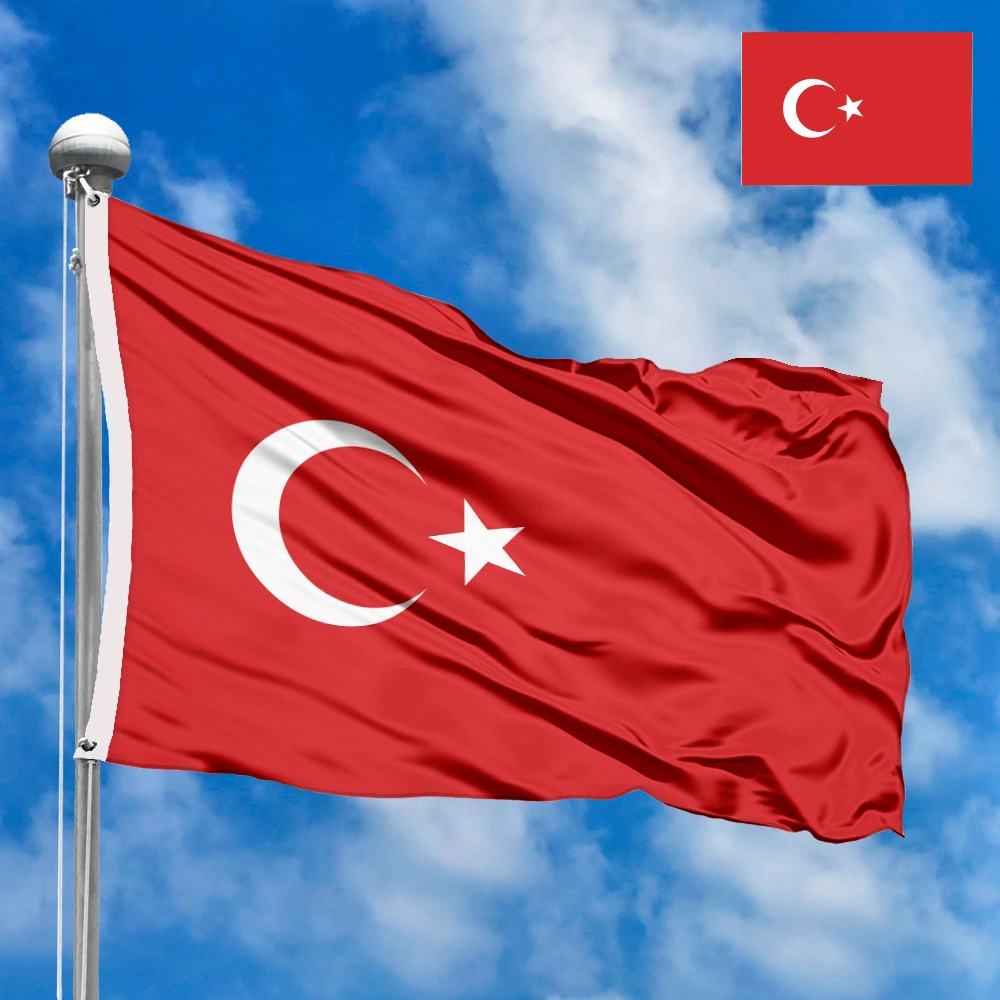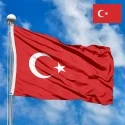The National Flag of the Republic of Turkey, known affectionately as "Ay Yıldız" (Moon-Star), is a potent emblem that encapsulates centuries of history, the deep-rooted cultural identity of the Turkish people, and their unwavering dedication to independence. More than just a national symbol, it represents the sacrifices of the past, the unity of the present, and the aspirations for a vibrant future. Its iconic design, steeped in legend and historical events, makes it instantly recognizable worldwide as a beacon of Turkish sovereignty and national pride.
A Celestial Canvas: Description, Dimensions, and Element Arrangement
The Flag of Turkey features a striking design: a white star and crescent set against a vibrant red background. This distinct layout is both simple and deeply symbolic. The red color holds profound significance, primarily representing the blood shed by Turkish martyrs throughout history in their pursuit of independence and defence of the homeland. It's a vivid reminder of the sacrifices that forged the modern Turkish Republic. The white crescent moon is a long-standing symbol associated with Turkic peoples and Islam, reflecting the predominant faith in Turkey. It also symbolizes progress and growth. The white five-pointed star, positioned within the open embrace of the crescent, is said to represent sovereignty, nationhood, and the rising sun, symbolizing the bright future of the country.
The specific dimensions and placement of the elements are meticulously defined to ensure consistency. The official ratio of the flag's width to its length is 2:3. The crescent and star are precisely proportioned and positioned, ensuring their harmonious appearance on the red field. The points of the star typically align with the open ends of the crescent, creating a visually balanced and aesthetically pleasing composition. This precise arrangement is crucial for maintaining the flag's iconic and historically recognized form.
Whispers of Ages: The Flag's Creation and Evolution
The history of the Turkish flag is intricately woven with the Ottoman Empire's legacy and the birth of the modern Turkish Republic. While the specific origins of the crescent and star motif on a red field are subject to various historical accounts and legends, the design in its current form is widely accepted to have solidified during the late Ottoman period. One popular legend attributes the design to a dream of the founder of the Ottoman Empire, Osman I, who saw a moon and star emerge from his chest and stretch over the world. Another theory suggests it originated from the reflection of the moon and a star in a pool of blood after the Battle of Kosovo in 1389, symbolizing the victory and the fallen heroes.
The red colour became prominently associated with the Ottoman Empire's military banners and state flag, particularly from the 18th century onwards. The crescent and star motif was also widely used on various Ottoman flags. The modern design of the flag, with its specific dimensions and proportions, was officially adopted by the Turkish Republic on June 5, 1936, under Law No. 2893, following the reforms of Mustafa Kemal Atatürk, the founder of the Republic. This formalization ensured a standardized national flag, distinguishing it from historical Ottoman banners while retaining key symbolic elements. The adoption process was a deliberate act of forging a new, modern national identity while honoring historical continuity. The flag has since remained unchanged, serving as a powerful link between the glorious past and the vibrant present of Turkey.
Turkey's Identity Woven in Fabric: Significance for the Nation
The Flag of Turkey carries profound significance for the nation, embodying its sovereignty, independence, and the enduring spirit of the Turkish people. It serves as a constant and powerful reminder of the arduous struggle for freedom, particularly during the Turkish War of Independence, and the sacrifices made by generations of Turks to establish and protect their republic. For the government, it represents the foundational principles of the Republic: secularism, democracy, and national unity.
For the Turkish people, the "Ay Yıldız" is a source of immense national pride, unity, and deep reverence. It fosters a strong sense of collective identity, connecting individuals across all regions and backgrounds. It's prominently displayed on national holidays, at public gatherings, and in everyday life, from schools to homes, instilling patriotism and a shared sense of belonging. The flag symbolizes their resilience, their unyielding spirit in the face of adversity, and their collective aspirations for progress and peace. It represents the very soul of the Turkish nation, a testament to their historical legacy and their unwavering commitment to their homeland and its future. The vivid red and the celestial symbols evoke strong emotional responses, representing both the blood of martyrs and the hopeful future under a guiding star and crescent.
Intriguing Facets: Interesting Facts about the Flag of Turkey
-
Ancient Roots: The crescent and star motif has been used by various Turkic states and empires for centuries, long before the modern Turkish Republic.
-
"Ay Yıldız" (Moon-Star): This is the affectionate and common name given to the flag by the Turkish people, highlighting its iconic celestial elements.
-
Legendary Origins: One popular legend links the flag's design to a dream of Osman I, the founder of the Ottoman Empire, or to the reflection of the moon and a star in a pool of blood after a major battle.
-
Symbol of Sacrifice: The red color is universally understood in Turkey to represent the blood of martyrs who died for the nation's freedom and independence.
-
Islamic and Turkic Symbolism: The crescent moon has deep roots in both Islamic and ancient Turkic cultures, representing progress and growth.
-
Standardized in the Republic: While similar designs existed in the Ottoman Empire, the current flag with its precise dimensions and proportions was formally adopted by the Turkish Republic in 1936.
-
No Other Official Symbols: The simplicity of the design, with only the crescent and star, makes it highly distinctive and powerful, avoiding complex heraldry.
-
Celebrated Daily: The flag is omnipresent in Turkey, displayed with immense pride on virtually every public building, in homes, and at various events.
-
Protected by Law: Turkish law strictly regulates the use and display of the flag, ensuring it is treated with the utmost respect and reverence.
The Moment of Formalization: Adoption and Reception
The formal adoption and standardization of the current design of the Turkish Flag occurred on June 5, 1936, through Law No. 2893, during the early years of the Turkish Republic. While the red background with the white crescent and star had been in use by the Ottoman Empire for centuries in various forms, this legislation definitively set the precise dimensions, proportions, and exact placement of the star and crescent for the national flag of the new republic. This act was a critical part of Mustafa Kemal Atatürk's reforms aimed at modernizing and solidifying the identity of the nascent Turkish state.
The reception of the flag by the Turkish people was one of profound acceptance and pride. It represented continuity with their historical heritage, particularly the Ottoman legacy, while also symbolizing a new era of national sovereignty and republican values. The adoption formalized a beloved symbol that resonated deeply with the populace, having been present in various forms for generations. Today, the flag's status is further enshrined and protected by the Turkish Constitution and specific laws, which govern its use and ensure it is always treated with the highest level of respect and reverence throughout the country. Its formalization solidified its role as the paramount symbol of the Turkish nation's independence and identity.
A Beacon of Identity: Meaning for Residents
For the residents of Turkey, the national flag is far more than just a piece of fabric; it's a living, breathing emblem that evokes a powerful sense of identity, pride, and unwavering patriotism. The vibrant red resonates deeply, reminding them of the countless sacrifices made by their ancestors to secure the nation's freedom and independence. It's a color that speaks of courage, blood shed, and an unyielding will to protect their homeland. The white crescent moon symbolizes progress, purity, and the historical connection to their Turkic and Islamic heritage, while the white star represents sovereignty, nationhood, and the bright future they collectively strive for.
Seeing the "Ay Yıldız" proudly waving—whether on a flagpole, displayed on a building, or worn during national celebrations—instills a profound sense of unity and shared purpose. It connects every citizen, regardless of background, to a common history and a collective destiny. It's a reminder of their resilience as a people, their commitment to democratic values, and their unique place in the world. The flag is deeply woven into the fabric of Turkish society, serving as a constant visual affirmation of their identity, their cherished independence, and their hopeful aspirations for the future.
In the demonstration images, full-size flags are shown with proportions of 2:3, and hand-held flags with proportions of 1:2.












 Waving flag
Waving flag
 Sizes:
Sizes:
 Round flag
Round flag
 Sizes:
Sizes:
 Rectangular flag 2:3
Rectangular flag 2:3
 Sizes:
Sizes: